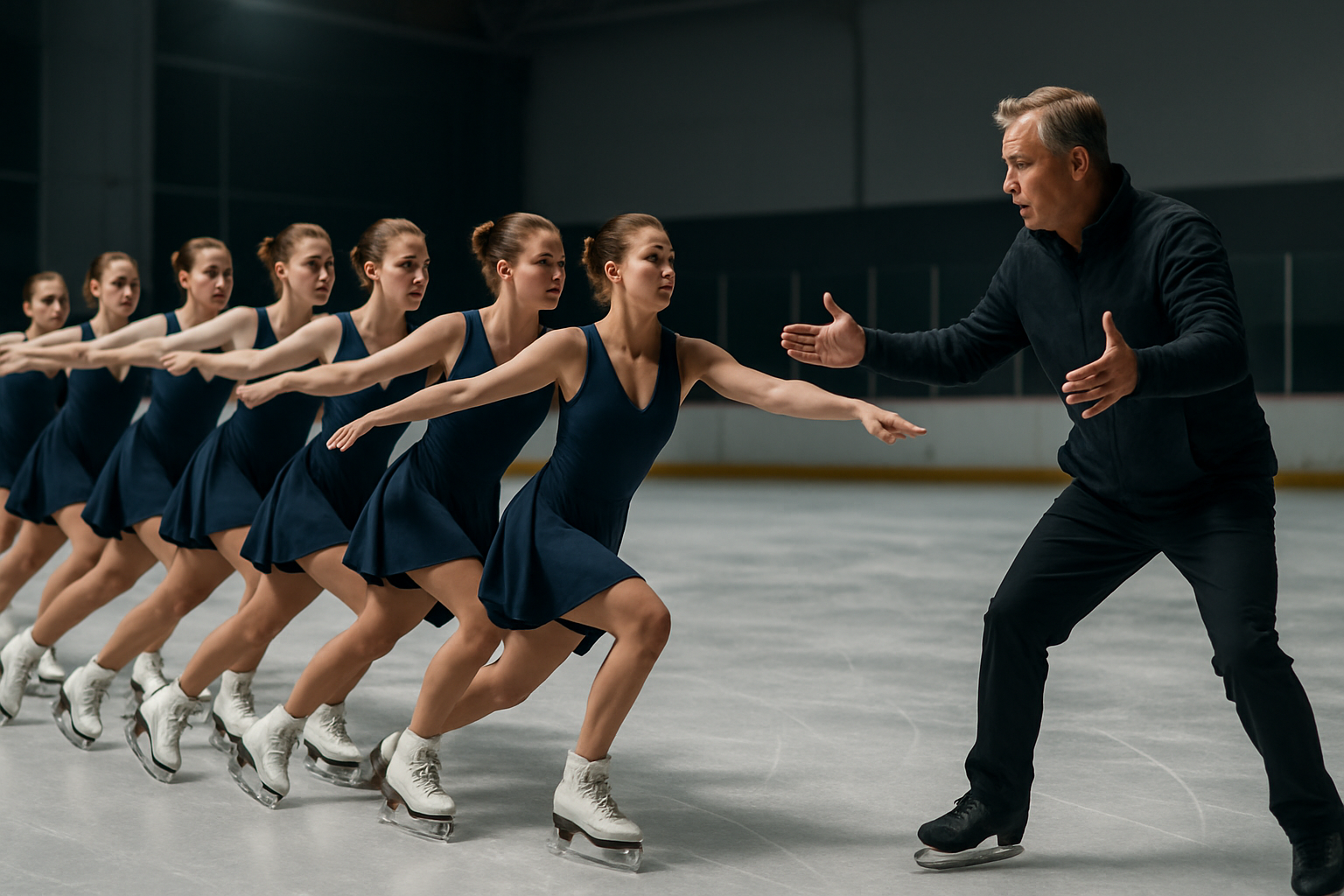Synchro Skating: The Choreographed Symphony on Ice
Imagine a frozen canvas where twenty synchronized figures glide in perfect harmony, their blades carving intricate patterns as they move as one. This is the world of synchro skating, a discipline that combines the grace of figure skating with the precision of synchronized swimming. As teams of skaters execute complex formations and transitions, they create a mesmerizing spectacle that pushes the boundaries of what's possible on ice.

In its early days, synchro skating primarily consisted of simple line formations and basic elements. Teams would perform straightline step sequences and wheel formations, focusing on maintaining perfect synchronization. As the sport gained popularity, particularly in the 1970s and 1980s, more complex elements were introduced, and the artistic component began to play a larger role in performances.
The International Skating Union (ISU) officially recognized synchronized skating as a discipline in 1994, marking a significant milestone in the sport’s history. This recognition led to the establishment of international competitions and standardized judging criteria, propelling synchro skating onto the global stage.
The Anatomy of a Synchro Team
A typical synchronized skating team consists of 16 skaters, although some divisions allow for variations in team size. The sport is unique in its emphasis on collective performance rather than individual prowess. Each skater must not only execute their own movements flawlessly but also maintain perfect synchronization with their teammates.
Synchro teams are divided into various levels based on age and skill, ranging from juvenile to senior. At the highest level, senior teams compete in international competitions, showcasing intricate programs that combine technical difficulty with artistic expression.
The roles within a synchro team are diverse and crucial to the overall performance. Lead skaters, often positioned at the front of formations, set the pace and provide visual cues for the rest of the team. Middle skaters maintain the integrity of formations, while end skaters are responsible for executing precise turns and transitions.
The Choreographic Challenge
Creating a synchronized skating program is a complex process that requires a delicate balance of creativity and technical precision. Choreographers must design routines that not only showcase the team’s strengths but also meet the strict requirements set by the ISU.
A typical competitive program includes a variety of elements, such as:
-
Block formations: Skaters move in tight, rectangular formations, often incorporating step sequences and changes of configuration.
-
Circles: Teams create circular patterns, executing turns and steps while maintaining the shape.
-
Wheels: Skaters form spokes radiating from a central point, rotating as a unit.
-
Intersections: Lines or shapes of skaters pass through each other, requiring split-second timing and precision.
-
Lifts and pair elements: In senior-level programs, teams may incorporate limited lifts and pair skating moves.
Choreographers must weave these elements together seamlessly, creating transitions that flow naturally and maintain the program’s artistic integrity. Music selection plays a crucial role, with teams often choosing pieces that allow for both powerful, synchronized movements and more nuanced, expressive sections.
The Physical and Mental Demands
Synchronized skating is a physically demanding sport that requires a unique combination of strength, flexibility, and endurance. Skaters must maintain high levels of cardiovascular fitness to execute four-minute programs with intensity and precision. Core strength is particularly crucial, as it allows skaters to maintain proper body position and execute quick direction changes.
The sport also places significant emphasis on edge control and skating skills. Synchro skaters must be able to perform complex step sequences and turns while maintaining perfect unison with their teammates. This requires hours of dedicated practice, both on and off the ice.
Mental preparation is equally important in synchronized skating. The need for absolute synchronization means that skaters must develop an acute awareness of their teammates’ movements and positions on the ice. Concentration and focus are paramount, as a single misstep can disrupt the entire team’s performance.
Team dynamics play a crucial role in synchro skating success. Coaches and sports psychologists work with teams to develop trust, communication, and a shared sense of purpose. The ability to move as one requires not just physical synchronization but also a deep emotional connection among team members.
Training Methodologies in Synchro Skating
The training regimen for synchronized skaters is multifaceted, combining on-ice practice with off-ice conditioning and mental preparation. A typical training week for a competitive synchro team might include:
-
On-ice sessions: Teams spend several hours each week on the ice, practicing elements, refining choreography, and working on synchronization. These sessions often involve repetitive drills to perfect timing and positioning.
-
Off-ice conditioning: Strength training, cardiovascular exercise, and flexibility work are essential components of a synchro skater’s routine. Plyometric exercises help develop the explosive power needed for jumps and quick direction changes.
-
Dance training: Many teams incorporate ballet or modern dance classes into their training to improve posture, line, and artistic expression.
-
Mental preparation: Visualization techniques and mindfulness practices help skaters develop the focus and mental resilience required for high-level competition.
-
Team-building activities: Coaches often organize off-ice activities to strengthen team bonds and improve communication.
-
Video analysis: Teams frequently review recordings of their performances to identify areas for improvement and ensure perfect synchronization.
One of the unique challenges in synchro training is developing what coaches call “team sense” – the ability to feel and respond to the movements of teammates without visual cues. This intuitive understanding is developed through countless hours of practice and is often what separates top teams from their competitors.
The Global Landscape of Synchronized Skating
While synchronized skating originated in North America, it has grown into a truly global sport. Countries such as Finland, Sweden, and Russia have emerged as powerhouses, consistently producing top-ranked teams. The sport’s popularity has also grown significantly in Asia, with Japan and China developing strong programs in recent years.
The ISU World Synchronized Skating Championships, first held in 2000, represent the pinnacle of the sport. Teams from around the world compete for the title, showcasing the highest level of technical skill and artistic expression. The championships have played a crucial role in raising the profile of synchro skating and pushing the boundaries of what’s possible on the ice.
Despite its growth, synchronized skating faces challenges in gaining wider recognition. The sport is not currently included in the Winter Olympics, although there have been ongoing efforts to change this. Advocates argue that the inclusion of synchro in the Olympic program would not only recognize the skill and dedication of its athletes but also bring new audiences to the world of figure skating.
The Future of Synchro: Innovation and Evolution
As synchronized skating continues to evolve, teams and choreographers are constantly pushing the boundaries of creativity and technical difficulty. Recent trends in the sport include:
-
Increased athleticism: Programs are becoming more physically demanding, with teams incorporating more difficult transitions and elements.
-
Enhanced artistry: Choreographers are exploring new ways to express musicality and emotion through movement, creating more nuanced and sophisticated programs.
-
Technological integration: Some teams are experimenting with innovative costumes and lighting effects to enhance their performances.
-
Cross-disciplinary influences: Choreographers are drawing inspiration from other dance forms and even circus arts to create unique and captivating routines.
The judging system for synchronized skating has also evolved to encourage innovation. The ISU has introduced new elements and adjusted scoring criteria to reward creativity and risk-taking while maintaining the sport’s emphasis on precision and synchronization.
The Impact of Synchronized Skating on Athletes
Participation in synchronized skating offers numerous benefits to athletes beyond the thrill of competition. The sport fosters important life skills such as teamwork, time management, and perseverance. Many synchro skaters report that their experiences on the ice have helped them develop confidence and leadership abilities that translate to other areas of their lives.
The team aspect of synchro skating also provides a unique social environment. Unlike individual figure skating, which can be isolating, synchro creates a supportive community where athletes form lifelong friendships. This social component is particularly valuable for young skaters, providing a sense of belonging and shared purpose.
From a physical health perspective, synchronized skating offers a comprehensive workout that improves cardiovascular fitness, strength, and flexibility. The sport’s emphasis on proper body alignment and control can also contribute to better posture and reduced risk of injury in daily life.
Challenges and Opportunities in Synchro Skating
Despite its growth and the passion of its participants, synchronized skating faces several challenges:
-
Recognition: The sport struggles for mainstream recognition, often overshadowed by individual figure skating disciplines.
-
Funding: Without Olympic inclusion, many national skating federations provide limited support to synchro programs, making it difficult for teams to secure adequate training resources and competition opportunities.
-
Accessibility: The team nature of the sport can make it challenging for interested skaters to find local programs, particularly in areas with limited ice rink facilities.
-
Gender diversity: While men are welcome in synchronized skating, the sport remains predominantly female, limiting its potential reach and appeal.
However, these challenges also present opportunities for growth and innovation:
-
Digital platforms: Social media and streaming services offer new ways for synchro teams to showcase their sport and build a fan base.
-
Grassroots development: Community-based programs and introductory synchro classes can help attract new participants and build a stronger foundation for the sport.
-
Cross-discipline collaboration: Partnerships with other ice sports and dance forms could lead to exciting new hybrid events and performances.
-
Educational outreach: Increased efforts to introduce synchronized skating in schools and universities could help raise awareness and participation levels.
The Artistic and Athletic Balance
One of the most compelling aspects of synchronized skating is its unique balance of athletic prowess and artistic expression. Unlike many team sports that focus primarily on physical performance, synchro requires athletes to convey emotion, interpret music, and create visual art on ice.
This artistic component adds layers of complexity to the sport. Teams must not only execute difficult elements with precision but also tell a story or evoke a mood through their performance. Facial expressions, body language, and the overall energy of the team all contribute to the artistic score.
Choreographers in synchronized skating face the challenge of creating programs that showcase both the technical skills of the team and their ability to perform as a cohesive artistic unit. This often involves careful music selection, innovative use of formations to create visual impact, and the incorporation of subtle gestures and movements that enhance the overall narrative of the program.
The artistic aspect of synchro also allows for greater inclusivity. While top-level teams certainly require elite skating skills, the sport’s emphasis on teamwork and expression means that skaters with varying physical abilities can find roles that allow them to contribute meaningfully to a team’s performance.
The Role of Technology in Synchro Skating
As in many sports, technology is playing an increasingly important role in synchronized skating. Some of the technological advancements impacting the sport include:
-
Video analysis software: Teams use sophisticated programs to analyze their performances frame by frame, allowing for minute adjustments to improve synchronization.
-
Biometric sensors: Wearable technology helps coaches monitor skaters’ physical exertion and recovery, optimizing training schedules and preventing burnout.
-
Virtual reality training: Some teams are experimenting with VR technology to allow skaters to practice formations and transitions off the ice.
-
Costume innovation: Advanced materials are being used to create costumes that enhance performance while meeting the strict regulations of the sport.
-
Ice quality monitoring: Sophisticated systems for maintaining ice temperature and consistency ensure optimal skating conditions during practice and competition.
These technological tools are helping teams push the boundaries of what’s possible in synchronized skating, leading to more spectacular and precise performances.
The Global Community of Synchro Skating
One of the most remarkable aspects of synchronized skating is the strong sense of community that exists among participants worldwide. Despite the competitive nature of the sport, there is a palpable camaraderie among teams and a shared passion for advancing the discipline.
International competitions serve not only as platforms for athletic achievement but also as cultural exchanges. Teams from different countries often form friendships, sharing training tips and cultural experiences. This global network has been instrumental in spreading innovative techniques and choreographic ideas, contributing to the rapid evolution of the sport.
Social media has played a significant role in strengthening this global community. Platforms like Instagram and TikTok allow teams to share behind-the-scenes glimpses of their training, connect with fans, and inspire young skaters around the world. This digital presence has been particularly important in regions where synchro is less established, providing aspiring skaters with role models and a window into the sport’s possibilities.
The Educational Value of Synchronized Skating
Beyond its athletic and artistic merits, synchronized skating offers significant educational value to its participants. The sport teaches important life skills that extend far beyond the ice rink:
-
Teamwork: The very nature of synchro requires skaters to work together toward a common goal, learning to communicate effectively and support one another.
-
Time management: Balancing rigorous training schedules with academic responsibilities helps skaters develop strong organizational skills.
-
Perseverance: The process of perfecting complex routines teaches skaters the value of persistence and hard work.
-
Attention to detail: The precision required in synchro skating cultivates a meticulous approach that can benefit skaters in various aspects of their lives.
-
Cultural awareness: International competitions expose skaters to diverse cultures, fostering global understanding and respect.
-
Leadership: Team captains and senior skaters often take on leadership roles, developing skills that are valuable in future careers.
Many educational institutions are beginning to recognize these benefits, with some colleges and universities in North America and Europe offering scholarships for synchronized skaters. This recognition not only provides opportunities for athletes to continue their sport at a high level but also acknowledges the valuable skills developed through participation in synchro.
The Health Benefits of Synchronized Skating
Participation in synchronized skating offers a wide range of health benefits, making it an excellent choice for individuals looking to improve their physical and mental well-being:
-
Cardiovascular health: The intense aerobic nature of synchro skating improves heart and lung function, reducing the risk of cardiovascular diseases.
-
Muscular strength and endurance: The sport engages multiple muscle groups, particularly in the lower body and core, leading to improved overall strength and tone.
-
Balance and coordination: The precise movements required in synchro skating enhance proprioception and body awareness.
-
Flexibility: Regular stretching and the execution of various skating elements improve overall flexibility and range of motion.
-
Bone density: As a weight-bearing exercise, skating can help maintain and even increase bone density, reducing the risk of osteoporosis later in life.
-
Mental health: The combination of physical activity, social interaction, and artistic expression can have positive effects on mood and mental well-being.
-
Cognitive function: The need to remember complex routines and make split-second decisions during performances can improve memory and cognitive agility.
These health benefits, combined with the sport’s emphasis on teamwork and artistic expression, make synchronized skating a uniquely holistic form of physical activity.
Synchro Skating and Inclusivity
While synchronized skating has traditionally been a female-dominated sport, there is a growing movement to make it more inclusive and diverse. Some teams and organizations are actively working to break down gender barriers and attract a wider range of participants:
-
Mixed-gender teams: Some competitions now include categories for mixed-gender teams, allowing male and female skaters to compete together.
-
Adaptive synchro: Programs are being developed to include skaters with physical disabilities, showcasing the sport’s potential for inclusivity.
-
Cultural diversity: As the sport spreads globally, teams are becoming more culturally diverse, bringing new perspectives and styles to the ice.
-
Age inclusivity: Adult synchro teams are growing in popularity, allowing skaters to continue participating in the sport well beyond their competitive years.
These initiatives not only broaden the appeal of synchronized skating but also enrich the sport with diverse experiences and perspectives, leading to new creative possibilities on the ice.
The Economic Impact of Synchronized Skating
While not as commercially prominent as some individual figure skating disciplines, synchronized skating has a significant economic impact in many regions:
-
Tourism: International competitions bring teams and spectators from around the world, boosting local economies through hotel stays, dining, and tourism activities.
-
Ice rink utilization: Synchro teams often use ice time during off-peak hours, helping rinks maintain profitability and stay open.
-
Equipment and apparel: The sport drives sales in specialized skating equipment, costumes, and team merchandise.
-
Coaching and support services: Synchro creates employment opportunities for coaches, choreographers, and various support professionals.
-
Youth development: Local synchro programs can attract young people to ice sports, supporting the broader skating industry.
As the sport continues to grow, its economic footprint is likely to expand, potentially attracting more sponsors and media attention.
The Future of Synchronized Skating: Challenges and Opportunities
As synchronized skating looks to the future, it faces both challenges and exciting opportunities:
Challenges:
-
Olympic recognition: The ongoing quest for Olympic inclusion remains a significant hurdle for the sport’s global recognition.
-
Funding: Securing adequate funding for teams and competitions, particularly in developing skating nations, is an ongoing challenge.
-
Balancing tradition and innovation: The sport must evolve to attract new audiences while maintaining its core principles and appeal to long-time fans.
-
Media coverage: Increasing mainstream media coverage to build a wider fan base remains a challenge.
Opportunities:
-
Technological integration: Embracing new technologies in training, performance, and fan engagement could revolutionize the sport.
-
Educational partnerships: Collaborations with schools and universities could introduce the sport to new audiences and provide academic opportunities for skaters.
-
Cross-disciplinary events: Hybrid events combining syn





